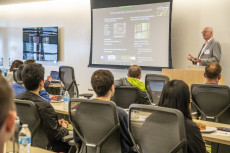Computing Sciences Summer Student Program Draws 90-plus Participants
June 7, 2018

During the June 5 kick-off, CSSS Program Chair Osni Marques and Computing Sciences Deputy Jonathan Carter went over details of the 12-week program, which offers undergraduate and graduate students in science and engineering fields the chance to gain research experience with ESnet, NERSC and the Computational Research Division. Image: Marilyn Chung, Berkeley Lab
On Tuesday, June 5, the Computing Sciences Summer Student (CSSS) Program welcomed dozens of college students from around the world to Berkeley Lab with a kick-off lunch and overview of the program. During their two months here, the students will have the opportunity to tour a state-of-the art supercomputer facility, peer into the heart of massive supernovae using math and computing and participate in hands-on programming workshops.
“As a member of this select group of students, their participation in the Berkeley Lab Summer Student Program will contribute important and valuable insights to their future professional development,” said Osni Marques, who chairs the CSSS Program.
The 12-week program, which was initially launched in 2010, offers undergraduate and graduate students in science and engineering fields the chance to gain research experience with ESnet, NERSC and the Computational Research Division. In addition to completing a research project, the students are given the opportunity to attend weekly talks, tour Berkeley Lab facilities (including NERSC's computer room and the ALS) and present a poster outlining their summer project. In addition, in response to student feedback from previous years, two new hands-on classes have been added: NERSC New User Training and Introduction to Parallel Programming.
“Every year we get more than 90 students during the summer coming to the lab through the CSSS program,” Marques said. “It is an opportunity for them to get to know each other, network, exchange ideas on their research assignments and be exposed to career opportunities.”
Summer also brings an influx of faculty/student research teams courtesy of a joint effort between CS and the Sustainable Horizons Institute through the Sustainable Pathways Program. This program aims to recruit students and faculty from a variety of institutions, including minority-serving institutions and women’s colleges supporting students from under-represented or under-privileged backgrounds, for summer research opportunities with the CS organization. As winners of Sustainable Pathways Research Fellowships, these teams spend the summer collaborating with Berkeley Lab staff to further their own research. This year 12 faculty/student teams received the fellowships.
“Our goal with this program is to make connections with faculty and students we might not otherwise connect with and to contribute to our diversity,” said CRD Director David Brown, who worked with the Sustainable Horizons Institute to develop the Pathways program.
To see the schedule of events and talks for the 2018 CSSS Program, click here.
About NERSC and Berkeley Lab
The National Energy Research Scientific Computing Center (NERSC) is a U.S. Department of Energy Office of Science User Facility that serves as the primary high performance computing center for scientific research sponsored by the Office of Science. Located at Lawrence Berkeley National Laboratory, NERSC serves almost 10,000 scientists at national laboratories and universities researching a wide range of problems in climate, fusion energy, materials science, physics, chemistry, computational biology, and other disciplines. Berkeley Lab is a DOE national laboratory located in Berkeley, California. It conducts unclassified scientific research and is managed by the University of California for the U.S. Department of Energy. »Learn more about computing sciences at Berkeley Lab.








